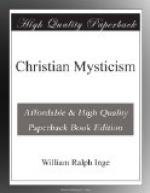[Footnote 227: See, especially, Stoeckl, Geschichte der Philosophie des Mittelalters, vol. i. pp. 382-384.]
[Footnote 228: It is hardly necessary to point out that St. Paul’s distinction between natural and spiritual (see esp. 1 Cor. ii.) is wholly different.]
[Footnote 229: Contrast the Plotinian doctrine of ecstasy with the following: “Dieu eleve a son gre aux plus hauts sommets, sans aucun merite prealable. Osanne de Mantoue recoit le don de la contemplation a peine agee de six ans. Christine est fiancee a dix ans, pendant une extase de trois jours; Marie d’Agreda recut des illuminations des sa premiere enfance” (Ribet). Since Divine favours are believed to be bestowed in a purely arbitrary manner, the fancies of a child left alone in the dark are as good as the deepest intuitions of saint, poet, or philosopher. Moreover, God sometimes “asserts His liberty” by “elevating souls suddenly and without transition from the abyss of sin to the highest summits of perfection, just as in nature He asserts it by miracles” (Ribet). Such teaching is interesting as showing how the admission of caprice in the world of phenomena reacts upon the moral sense and depraves our conception of God and salvation. The faculty of contemplation, according to Roman Catholic teaching, is acquired “either by virtue or by gratuitous favour.” The dualism of natural and supernatural thus allows men to claim independent merit, while the interventions of God are arbitrary and unaccountable.]
[Footnote 230: Those who are interested to see how utterly defenceless this theory leaves us against the silliest delusions, may consult with advantage the Dictionary of Mysticism, by the Abbe Migne (passim), or, if they wish to ascend nearer to the fountain-head of these legends, there are the sixty folio volumes of Acta Sanctorum, compiled by the Bollandists. Goerres and Ribet are also very full of these stories.]
[Footnote 231: See Appendix C.]
[Footnote 232: The difference between contemplation and meditation is explained by all the mediaeval mystics. Meditation is “discursive,” contemplation is “mentis in Deum suspensae elevatio.” Richard of St. Victor states the distinction epigrammatically—“per meditationem rimamur, per contemplationem miramur.” ("Admiratio est actus consequens contemplationem sublimis veritatis.”—Thomas Aquinas.)]
[Footnote 233: This arbitrary schematism is very characteristic of this type of Mysticism, and shows its affinity to Indian philosophy. Compare “the eightfold path of Buddha,” and a hundred other similar classifications in the sacred books of the East.]
[Footnote 234: The date usually given, 1260, is probably too late; but the exact year cannot be determined.]




